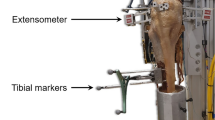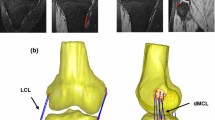Abstract
Purpose
The primary intent of total knee arthroplasty is the restoration of normal knee kinematics, with ligamentous constraint being a key influential factor. Displacement of the joint line may lead to alterations in ligament attachment sites relative to knee flexion axis and variance of ligamentous constraints on tibiofemoral movement. This study aimed to investigate collaterals strains and tibiofemoral kinematics with different joint line levels.
Methods
A previously validated knee model was employed to analyse the change in length of the collateral ligaments and tibiofemoral motion during knee flexion. The models shifted the joint line by 3 and 5 mm both proximally and distally from the anatomical level. The data were captured from full extension to flexion 135°.
Results
The elevated joint line revealed a relative increase in distance between ligament attachments for both collateral ligaments in comparison with the anatomical model. Also, tibiofemoral movement decreased with an elevation in the joint line. Conversely, lowering the joint line led to a significant decrease in distance between ligament attachments, but greater tibiofemoral motion.
Conclusion
Elevation of the joint line would strengthen the capacity of collateral ligaments for knee motion constraint, whereas a distally shifted joint line might have the advantage of improving tibiofemoral movement by slackening the collaterals. It implies that surgeons can appropriately change the joint line position in accordance with patient’s requirement or collateral tensions. A lowered joint line level may improve knee kinematics, whereas joint line elevation could be useful to maintain knee stability.
Level of evidence
V.






Similar content being viewed by others
References
Abdel-Rahman EM, Hefzy MS (1998) Three-dimensional dynamic behaviour of the human knee joint under impact loading. Med Eng Phys 20:276–290
Amis AA, Zavras TD (1995) Isometricity and graft placement during anterior cruciate ligament reconstruction. Knee 2:5–17
Asano H, Hoshino A, Wilton TJ (2004) Soft tissue tension in total knee arthroplasty. J Arthroplasty 19:558–561
Baldwin MA, Laz PJ, Stowe JQ, Rullkoetter PJ (2009) Efficient probabilistic representation of tibiofemoral soft tissue constraint. Comput Methods Biomech Biomed Engin 12:651–659
Banks SA, Hodge WA (2004) Design and activity dependence of kinematics in fixed and mobile-bearing knee arthroplasty. J Arthroplasty 19:809–816
Churchill DL, Incavo SJ, Johnson CC, Beynnon BD (1998) The transepicondylar axis approximates the optimal flexion axis of the knee. Clin Orthop Relat Res 356:111–118
Cope MR, O’Brien BS, Nanu AM (2002) The influence of the posterior cruciate ligament in the maintenance of joint line in primary total knee arthroplasty: a radiologic study. J Arthroplasty 17:206–208
Dennis DA, Komistek RD, Mahfouz MR, Walker SA, Tucker A (2004) A multicenter analysis of axial femorotibial rotation after total knee arthroplasty. Clin Orthop Relat Res 428:180–189
D’Lima DD, Patil S, Steklov N, Chien S, Colwell CW Jr (2007) In vivo knee moments and shear after total knee arthroplasty. J Biomech 40(Suppl 1):11–17
Edwards E, Miller J, Chan KH (1988) The effect of postoperative collateral ligament laxity in total knee arthroplasty. Clin Orthop Relat Res 236:44–51
Estupiñán JA, Bartel DL, Wright TM (1998) Residual stresses in ultra-high molecular weight polyethylene loaded cyclically by a rigid moving indenter in nonconforming geometries. J Orthop Res 1:80–88
Gardiner JC, Weiss JA, Rosenberg TD (2001) Strain in the human medial collateral ligament during valgus loading of the knee. Clin Orthop Relat Res 391:266–274
Godest AC, Beaugonin M, Haug E, Taylor M, Gregson PJ (2002) Simulation of a knee joint replacement during a gait cycle using explicit finite element analysis. J Biomech 35:267–275
Halewood C, Risebury M, Thomas NP, Amis AA (2014) Kinematic behaviour and soft tissue management in guided motion total knee replacement. Knee Surg Sports Traumatol Arthrosc. doi:10.1007/s00167-014-2933-5
Harato K, Bourne RB, Victor J, Snyder M, Hart J, Ries MD (2008) Midterm comparison of posterior cruciate-retaining versus–substituting total knee arthroplasty using the Genesis II prosthesis. A multicenter prospective randomized clinical trial. Knee 15:217–221
Harfe DT, Chuinard CR, Espinoza LM, Thomas KA, Solomonow M (1998) Elongation patterns of the collateral ligaments of the human knee. Clin Biomech (Bristol, Avon) 13:163–175
Healy WL, Iorio R, Lemos MJ (2000) Athletic activity after total knee arthroplasty. Clin Orthop Relat Res 380:65–71
Hemmerich A, Brown H, Smith S, Marthandam SS, Wyss UP (2006) Hip, knee, and ankle kinematics of high range of motion activities of daily living. J Orthop Res 24:770–781
Höher J, Harner CD, Vogrin TM, Baek GH, Woo SL (1998) In situ forces in the posterolateral structures of the knee under posterior tibial loading in the intact and posterior cruciate ligament-deficient knee. J Orthop Res 16:675–681
Howell SM, Papadopoulos S, Kuznik KT, Hull ML (2013) Accurate alignment and high function after kinematically aligned TKA performed with generic instruments. Knee Surg Sports Traumatol Arthrosc 21:2271–2280
Huang CH, Hsu LI, Lin KJ, Chang TK, Cheng CK, Lu YC, Chen CS, Huang CH (2014) Patellofemoral kinematics during deep knee flexion after total knee replacement: a computational simulation. Knee Surg Sports Traumatol Arthrosc. doi:10.1007/s00167-013-2819-y
Insall J, Scott WN, Renawat CS (1979) The total condylar knee prosthesis: a report of two hundred and twenty cases. J Bone Joint Surg Am 61:173–180
Iwaki H, Pinskerova VP, Freeman MAR (2000) Tibiofemoral movement 1: the shapes and relative movements of the femur and tibia in the unloaded cadaver knee. J Bone Joint Surg Br 82:1189–1195
Jeffcote B, Nicholls R, Schirm A, Kuster MS (2007) The variation in medial and lateral collateral ligament strain and tibiofemoral forces following changes in the flexion and extension gaps in total knee replacement. A laboratory experiment using cadaver knees. J Bone Joint Surg Br 89:1528–1533
Kessler O, Dürselen L, Banks S, Mannel H, Marin F (2007) Sagittal curvature of total knee replacements predicts in vivo kinematics. Clin Biomech (Bristol, Avon) 22:52–58
Kessler O, Patil S, Colwell CWJ, D’Lima DD (2008) The effect of femoral component malrotation on patellar biomechanics. J Biomech 41:3332–3339
König C, Matziolis G, Sharenkov A, Taylor WR, Perka C, Duda GN, Heller M (2011) Collateral ligament length change patterns after joint line elevation may not explain midflexion instability following TKA. Med Eng Phys 33:1303–1308
Kuster MS, Bitschnau B, Votruba T (2004) Influence of collateral ligament laxity on patient satisfaction after total knee arthroplasty: a comparative bilateral study. Arch Orthop Trauma Surg 124:415–417
Li G, Most E, Sultan PG, Schule S, Zayontz S, Park SE, Rubash HE (2004) Knee kinematics with a high-flexion posterior stabilized total knee prosthesis: an in vitro robotic experimental investigation. J Bone Joint Surg Am 86:1721–1729
Lin KJ, Huang CH, Liu YL, Chen WC, Chang TW, Yang CT, Lai YS, Cheng CK (2011) Influence of post-cam design of posterior stabilized knee prosthesis on tibiofemoral motion during high knee flexion. Clin Biomech (Bristol, Avon) 26:847–852
McFadyen BJ, Winter DA (1988) An integrated biomechanical analysis of normal stair ascent and descent. J Biomech 21:733–744
Merkow RL, Soudry M, Insall JN (1985) Patellar dislocation following total knee replacement. J Bone Joint Surg Am 67:1321–1327
Mesfar W, Shirazi-Adl A (2005) Biomechanics of the knee joint in flexion under various quadriceps forces. Knee 12:424–434
Moonot P, Mu S, Railton GT, Field RE, Banks SA (2009) Tibiofemoral kinematic analysis of knee flexion for a medial pivot knee. Knee Surg Sports Traumatol Arthrosc 17:927–934
Noble PC, Gordon MJ, Weiss JM, Reddix RN, Conditt MA, Mathis KB (2005) Does total knee replacement restore normal knee function? Clin Orthop Relat Res 431:157–165
Piazza SJ, Delp SL (2001) Three-dimensional dynamic simulation of total knee replacement motion during a step-up task. J Biomech Eng 123:599–606
Ritter MA, Montgomery TJ, Zhou H (1999) The clinical significance of proximal tibial resection level in total knee arthroplasty. Clin Orthop Relat Res 360:74–181
Ritter MA, Harty LD, Davis KE, Meding JB, Berend ME (2003) Predicting range of motion after total knee arthroplasty. Clustering, log-linear regression, and regression tree analysis. J Bone Joint Surg Am 85:1278–1285
Ryu J, Saito S, Yamamoto K, Sano S (1993) Factors influencing the postoperative range of motion in total knee arthroplasty. Bull Hosp Jt Dis 53:35–40
Sharkey PF, Hozack WJ, Booth RE, Balderston RA, Rothman RH (1992) Posterior dislocation of total knee arthroplasty. Clin Orthop Relat Res 278:128–133
Shoji H, Solomonow M, Yoshino S, D’Ambrosia R, Dabezies E (1990) Factors affecting postoperative flexion in total knee arthroplasty. Orthopedics 13:643–649
Taylor WR, Heller MO, Bergmann G, Duda GN (2004) Tibio-femoral loading during human gait and stair climbing. J Orthop Res 22:625–632
van Duren BH, Pandit H, Price M, Tilley S, Gill HS, Murray DW, Thomas NP (2012) Bicruciate substituting total knee replacement: how effective are the added kinematic constraints in vivo? Knee Surg Sports Traumatol Arthrosc 20:2002–2010
van Eijden TM, de Boer W, Weijs WA (1985) The orientation of the distal part of the quadriceps femoris muscle as a function of the knee flexion-extension angle. J Biomech 18:803–809
Wang ZW, Liu YL, Lin KJ, Qu TB, Dong X, Cheng CK, Hai Y (2012) The effects of implantation of tibio-femoral components in hyperextension on kinematics of TKA. Knee Surg Sports Traumatol Arthrosc 20:2032–2038
Weiss JM, Noble PC, Conditt MA, Kohl HW, Roberts S, Cook KF, Gordon MJ, Mathis KB (2002) What functional activities are important to patients with knee replacements? Clin Orthop Relat Res 404:172–188
Willing R, Kim IY (2011) Design optimization of a total knee replacement for improved constraint and flexion kinematics. J Biomech 44:1014–1020
Zhao D, Banks SA, D’Lima DD, Colwell CW, Fregly BJ (2007) In vivo medial and lateral tibial loads during dynamic and high flexion activities. J Orthop Res 25:593–602
Acknowledgments
We acknowledge the financial support of the Administrative Bureau of Southern Taiwan Science Park (BY-03-04-17-98).
Conflict of interest
No conflicts of interest on this manuscript.
Author information
Authors and Affiliations
Corresponding author
Additional information
Hung-Wen Wei and Chang-Hung Huang have equally contributed to this work.
Rights and permissions
About this article
Cite this article
Lin, KJ., Wei, HW., Huang, CH. et al. Change in collateral ligament length and tibiofemoral movement following joint line variation in TKA. Knee Surg Sports Traumatol Arthrosc 24, 2498–2505 (2016). https://doi.org/10.1007/s00167-014-3400-z
Received:
Accepted:
Published:
Issue Date:
DOI: https://doi.org/10.1007/s00167-014-3400-z




